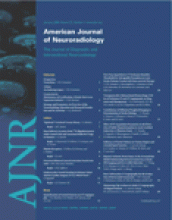Research ArticleBRAIN
Hypoxic-Ischemic Brain Injury in the Neonatal Rat Model: Relationship between Lesion Size at Early MR Imaging and Irreversible Infarction
Y. Wang, P.-T. Cheung, G.X. Shen, E.X. Wu, G. Cao, I. Bart, W.H.S. Wong and P.-L. Khong
American Journal of Neuroradiology January 2006, 27 (1) 51-54;
Y. Wang
P.-T. Cheung
G.X. Shen
E.X. Wu
G. Cao
I. Bart
W.H.S. Wong

References
- ↵Volpe JJ. Perinatal brain injury: from pathogenesis to neuroprotection. Ment Retard Dev Disabil Res Rev 2001;7:56–64
- ↵Adcock KH, Nedelcu J, Loenneker T, et al. Neuroprotection of creatine supplementation in neonatal rats with transient cerebral hypoxia-ischemia. Dev Neurosci 2002;24:382–88
- Lee JH, Lee YK, Ishikawa M, et al. Cilostazol reduces brain lesion induced by focal cerebral ischemia in rats–an MRI study. Brain Res 2003;994:91–98
- Petty MA, Neumann-Haefelin C, Kalisch J, et al. In vivo neuroprotective effects of ACEA 1021 confirmed by magnetic resonance imaging in ischemic stroke. Eur J Pharmacol 2003;474:53–62
- ↵
- ↵Nedelcu J, Klein MA, Aguzzi A, et al. Resuscitative hypothermia protects the neonatal rat brain from hypoxic-ischemic injury. Brain Pathol 2000;10:61–71
- Wagner BP, Nedelcu J, Martin E. Delayed postischemic hypothermia improves long-term behavioral outcome after cerebral hypoxia-ischemia in neonatal rats. Pediatr Res 2002;51:354–60
- Williams GD, Dardzinski BJ, Buckalew AR, et al. Modest hypothermia preserves cerebral energy metabolism during hypoxia-ischemia and correlates with brain damage: a 31P nuclear magnetic resonance study in unanesthetized neonatal rats. Pediatr Res 1997;42:700–708
- ↵Gluckman PD, Wyatt JS, Azzopardi D, et al. Selective head cooling with mild systemic hypothermia after neonatal encephalopathy: multicentre randomised trial. Lancet 2005;19:365:663–70
- ↵Hagberg H, Bona E, Gilland E, et al. Hypoxia-ischaemia model in the 7-day-old rat: possibilities and shortcomings. Acta Paediatr Suppl 1997;422:85–88
- ↵Hagberg H, Ichord R, Palmer C, et al. Animal models of developmental brain injury: relevance to human disease: a summary of the panel discussion from the Third Hershey Conference on Developmental Cerebral Blood Flow and Metabolism. Dev Neurosci 2002;24:364–66
- ↵Vannucci RC, Connor JR, Mauger DT, et al. Rat model of perinatal hypoxic-ischemic brain damage. J Neurosci Res 1999;55:158–63
- ↵Roohey T, Raju TN, Moustogiannis AN. Animal models for the study of perinatal hypoxic-ischemic encephalopathy: a critical analysis. Early Hum Dev 1997;47:115–46
- ↵Qiao M, Malisza KL, Del Bigio MR, et al. Transient hypoxia-ischemia in rats: changes in diffusion-sensitive MR imaging findings, extracellular space, and Na+-K+ -adenosine triphosphatase and cytochrome oxidase activity. Radiology 2002;223:65–75
- ↵Ringer TM, Neumann-Haefelin T, Sobel RA, et al. Reversal of early diffusion-weighted magnetic resonance imaging abnormalities does not necessarily reflect tissue salvage in experimental cerebral ischemia. Stroke 2001;32:2362–69
- ↵Lythgoe MF, Thomas DL, Calamante F, et al. Acute changes in MRI diffusion, perfusion, T(1), and T(2) in a rat model of oligemia produced by partial occlusion of the middle cerebral artery. Magn Reson Med 2000;44:706–12
- ↵Ordidge R, Thornton J, Clemence M, et al. NMR studies of hypoxic-ischaemic injury in neonatal brain using imaging and spectroscopy. Adv Exp Med Biol 1997;428:539–44
- ↵Tuor UI, Kozlowski P, Del Bigio MR, et al. Diffusion- and T2-weighted increases in magnetic resonance images of immature brain during hypoxia-ischemia: transient reversal posthypoxia. Exp Neurol 1998;150:321–28
- ↵Nedelcu J, Klein MA, Aguzzi A, et al. Biphasic edema after hypoxic-ischemic brain injury in neonatal rats reflects early neuronal and late glial damage. Pediatr Res 1999;46:297–304
- ↵Miyasaka N, Nagaoka T, Kuroiwa T, et al. Histopathologic correlates of temporal diffusion changes in a rat model of cerebral hypoxia/ischemia. AJNR Am J Neuroradiol 2000;21:60–66
- ↵Rumpel H, Nedelcu J, Aguzzi A, et al. Late glial swelling after acute cerebral hypoxia-ischemia in the neonatal rat: a combined magnetic resonance and histochemical study. Pediatr Res 1997;42:54–59
- Miyasaka N, Kuroiwa T, Zhao FY, et al. Cerebral ischemic hypoxia: discrepancy between apparent diffusion coefficients and histologic changes in rats. Radiology 2000;215:199–204
- ↵Ning G, Malisza KL, Del Bigio MR, et al. Magnetic resonance imaging during cerebral hypoxia-ischemia: T2 increases in 2-week-old but not 4-week-old rats. Pediatr Res 1999;45:173–79
- ↵
- ↵Iadecola C, Zhang F, Xu X. Inhibition of inducible nitric oxide synthase ameliorates cerebral ischemic damage. Am J Physiol 1995;268:R286–92
- ↵
- ↵Olah L, Wecker S, Hoehn M. Relation of apparent diffusion coefficient changes and metabolic disturbances after 1 hour of focal cerebral ischemia and at different reperfusion phases in rats. J Cereb Blood Flow Metab 2001;21:430–39
- ↵Hoehn-Berlage M, Norris DG, Kohno K, et al. Evolution of regional changes in apparent diffusion coefficient during focal ischemia of rat brain: the relationship of quantitative diffusion NMR imaging to reduction in cerebral blood flow and metabolic disturbances. J Cereb Blood Flow Metab 1995;15:1002–11
In this issue
Advertisement
Y. Wang, P.-T. Cheung, G.X. Shen, E.X. Wu, G. Cao, I. Bart, W.H.S. Wong, P.-L. Khong
Hypoxic-Ischemic Brain Injury in the Neonatal Rat Model: Relationship between Lesion Size at Early MR Imaging and Irreversible Infarction
American Journal of Neuroradiology Jan 2006, 27 (1) 51-54;
0 Responses
Jump to section
Related Articles
- No related articles found.
Cited By...
This article has not yet been cited by articles in journals that are participating in Crossref Cited-by Linking.
More in this TOC Section
Similar Articles
Advertisement











